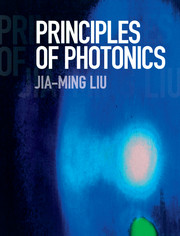Book contents
- Frontmatter
- Dedication
- Contents
- Preface
- Partial List of Symbols
- 1 Basic Concepts of Optical Fields
- 2 Optical Properties of Materials
- 3 Optical Wave Propagation
- 4 Optical Coupling
- 5 Optical Interference
- 6 Optical Resonance
- 7 Optical Absorption and Emission
- 8 Optical Amplification
- 9 Laser Oscillation
- 10 Optical Modulation
- 11 Photodetection
- Appendix A Symbols and Notations
- Appendix B SI Metric System
- Appendix C Fundamental Physical Constants
- Appendix D Fourier-Transform Relations
- Index
- References
6 - Optical Resonance
Published online by Cambridge University Press: 05 August 2016
- Frontmatter
- Dedication
- Contents
- Preface
- Partial List of Symbols
- 1 Basic Concepts of Optical Fields
- 2 Optical Properties of Materials
- 3 Optical Wave Propagation
- 4 Optical Coupling
- 5 Optical Interference
- 6 Optical Resonance
- 7 Optical Absorption and Emission
- 8 Optical Amplification
- 9 Laser Oscillation
- 10 Optical Modulation
- 11 Photodetection
- Appendix A Symbols and Notations
- Appendix B SI Metric System
- Appendix C Fundamental Physical Constants
- Appendix D Fourier-Transform Relations
- Index
- References
Summary
OPTICAL RESONATOR
As discussed in Section 5.3, multiple reflections take place between the two reflective surfaces of a Fabry–Pérot interferometer, resulting in multiple transmitted fields. A transmittance peak occurs when the round-trip phase shift φRT between the two reflective surfaces is an integral multiple of 2π so that all of the transmitted fields are in phase. From the viewpoint of the field inside the interferometer, this condition results in optical resonance between the two reflective surfaces. Thus a Fabry–Pérot interferometer behaves as an optical resonator, also called a resonant optical cavity. At resonance, the field amplitude inside an optical resonator reaches a peak value due to constructive interference of multiple reflections. The optical energy stored in an optical cavity peaks at its resonance frequencies.
An optical cavity can take a variety of forms. Figure 6.1 shows the schematic structures of a few different forms of optical cavities. Though an optical cavity has a clearly defined longitudinal axis, the axis can lie on a straight line, as in Fig. 6.1(a), or it can be defined by a folded path, as in Figs. 6.1(b), (c), and (d). A linear cavity defined by two end mirrors, as in Fig. 6.1(a), is known as a Fabry–Pérot cavity because it takes the form of the Fabry–Pérot interferometer. A folded cavity can simply be a folded Fabry–Pérot cavity that supports a standing intracavity field, as in Fig. 6.1(b). A folded cavity can also be a non-Fabry–Pérot ring cavity that supports two independent, contrapropagating intracavity fields, as in Figs. 6.1(c) and (d).
An optical cavity provides optical feedback to the optical field in the cavity. Optical resonance occurs when the optical feedback is in phase with the intracavity optical field. The optical feedback in a Fabry–Pérot cavity is provided simply by the two end mirrors that have the reflective surfaces perpendicular to the longitudinal axis, as in Figs. 6.1(a) and (b). In a ring cavity, it is provided by the circulation of the laser field along a ring path defined by mirrors, as in Fig. 6.1(c), or a ring path defined by an optical fiber, as in Fig. 6.1(d). The cavity can also be constructed with an optical waveguide, as in the case of a semiconductor laser or a fiber laser.
- Type
- Chapter
- Information
- Principles of Photonics , pp. 204 - 223Publisher: Cambridge University PressPrint publication year: 2016
References
- 1
- Cited by

